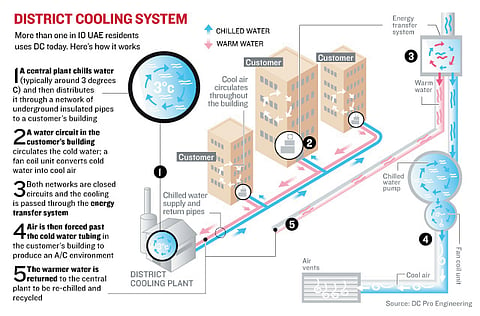Why is there so much consumer heat over district cooling?
People are unhappy about the service and would rather have a conventional system if they had the choice

I have no idea why it came to me to write this column except the fact that I am so disappointed with the cost of district cooling in an apartment I moved in few months ago. The subject is an example of what we read in university and reference books may not apply in reality.
District cooling is the production and distribution of chilled water in a central plant for the purpose of air-conditioning in a set of buildings or facilities. In colder countries it is the opposite of district heating and some countries have both depending on the weather.
As an engineer, I was so pleased to move into an area of Dubai where district cooling is provided and I thought of all the saving advantages that will accrue to me until I got the shock of receiving the first bill. I immediately went back to the books and the internet to see if science and economics have changed since I left university only to find out that the basic principles have not and that the practical application has been reinforced by efficiency and new standards due to the desire and popularity of such systems.
I want to quote few things. Wikipedia tells us that “The adoption of district cooling is estimated to reduce the consumption of electricity for cooling purposes by as much as 90 per cent and an exponential growth in usage is forecast”. Actually, and rightly so, exponential growth in the UAE and the rest of the Gulf happened in the last decade or so.
Energy reduction
The website of a district cooling company tells us that “District cooling is a superior alternative to conventional air-conditioning as it helps reduce energy consumption and costs to both customers and governments alike”. It goes on to cite 50 per cent less energy consumption, a decrease in initial capital investment, substantially lower maintenance cost and 30-year equipment replacement as compared to half that time for replacing conventional systems.
The website of another company tells us “Reduced capital and operating costs, reduced air-conditioning set-up for each building and cost benefits from substantially lower electricity usage and reduced maintenance”.
The CEO of another company tells us: “This new technology delivers optimal results, not only to customers but also to the society at a socio-economic level by reducing electricity and water consumption, and conserving the environment”.
All this is fine and I believe it is a true reflection of the advantages of district cooling over conventional air-conditioning. I also think that the energy savings, though site specific could be more than 50 per cent. Then why is everybody whom I talked to in my new district cooled region unhappy about the service and would rather have a conventional system if he has the choice?
The reason is the exorbitant bills that the tenants are getting from the providing companies defy the economics supposedly characterising this service. The energy services in my old one-bedroom apartment used to cost me about Dh4,800 a year.
Highly inflated
Moving a few kilometres away to the new two-bedroom apartment and, judging by the past few months, it is likely to come close to Dh17,000 a year where more than two-thirds is strictly for district cooling. This is totally unreasonable and highly inflated. If I and many other people knew this before the decision to move to the new area may have been different.
While the issue is new to me, it apparently has received good coverage in the press in recent years. Tenants are so upset that they are talking about rip-offs, scams and fleecing and complain about not receiving the proper explanation about the way rates are calculated by district cooling companies.
The way areas are calculated and consumption rates are metered by the cooling company will only repeat previous arguments that eventually amounted to nothing.
But let me say that this great industry cannot be left to the whims and wishes of district cooling companies and government intervention is absolutely essential to safeguard the rights of consumers and companies alike. A way must be found to regulate rates to reflect the advantages and savings of centralised systems.
UAE’s district cooling companies are not only expanding locally but in the GCC and the only way to ensure success is to carry the enthusiasm of the public by giving them the savings they are expected to get. There must be other ways to satisfy the rights of investing companies to recover their investment without harming consumers.
The writer is former head of the Energy Studies Department at the Opec Secretariat in Vienna.
Sign up for the Daily Briefing
Get the latest news and updates straight to your inbox

